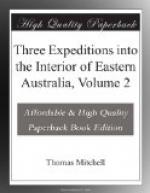The men were in general strong, healthy, and muscular, and among them was one who measured six feet four inches, as we afterwards ascertained at our camp. My chief object in visiting the lake was to cultivate a good understanding with these natives in the hopes that one of them might be induced to accompany me down the Lachlan. The facility with which Piper, then at a distance of 200 miles from his native place, Bathurst, conversed with these people showed that their dialects are not so varied as is commonly believed; and I had little doubt that he would be understood, even on the banks of the Darling.
THEIR ACCOUNT OF THE COUNTRY LOWER DOWN. OOLAWAMBILOA.
He ascertained from one of these natives of Regent’s lake that after eight of our daily journeys, according to his comprehension, the bed of the Lachlan would contain no water, and that we must go to the right across “the middle,” as Piper understood, reaching in four days more a lagoon called Burrabidgin or Burrabadimba: that there I must leave the carts and go with the native on horseback; and that in two days’ travelling at the rate we could then proceed, we should reach Oolawambiloa, a very great water. They also said that water could be found in the bush at the end of each of those four days’ journey by one of their tribe who would go with us and who had twice been at the great water. All this news made me impatient to go on; but we had to remain a day or two for the light cart. It rained heavily during the whole afternoon; nevertheless a body of these natives accompanied us back, keeping pace with our horses.
GAIETY OF THE NATIVES.
Each carried a burning torch of the resinous bark of the callitris, with the blaze of which these natives seemed to keep their dripping bodies warm, laughing heartily and passing their jokes upon us, our horses and particularly upon our two guides of their own race, Piper and Barney, who seemed anything but at home on horseback with wet clothes dripping about them.
COLOUR LIGHT.
These natives were of a bright copper colour, so different from black that one had painted his thighs with black chequered lines which made his skin very much resemble the dress of a harlequin.
MR. STAPYLTON SURVEYS THE LAKE.
Mr. Stapylton proceeded with a party to make a survey of Cudjallagong lake and creek, an operation which could be accomplished with less inconvenience as that gentleman’s equipment could not come up to us until the 16th.
CAMPBELL’S LAKE.
He extended his survey to the small lake to the north-east, the first discovered by Mr. Oxley and named by him Campbell’s lake. Mr. Stapylton found only a grassy plain without a drop of water. By an opening from Cudjallagong lake he proceeded to another likewise seen by Mr. Oxley. It had also become a verdant plain, nevertheless I thought it was necessary to distinguish it on my map by its native name of Goorongully, as Mr. Oxley had not supplied any to it.




